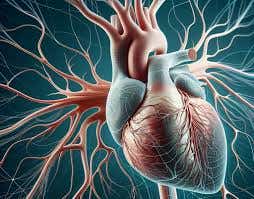The heart has its own ‘brain’ and here is why that is critical
Scientists uncover the heart’s intrinsic nervous system, revealing its role in regulating heartbeat and potential for cardiac therapies.

Researchers have discovered a “little brain” in the heart, capable of independent rhythm regulation. (CREDIT: AI-generated image created by Copilot)
Maintaining a stable heartbeat is critical for survival. Your heart must constantly adapt its output to meet changing demands for oxygen and nutrients. Traditionally, scientists have attributed this ability to the autonomic nervous system, which controls essential bodily functions like heart rate and digestion.
However, emerging research paints a more complex picture of how your heart functions, thanks to its own intrinsic nervous system, often referred to as the heart's "little brain."
This network, formally known as the intracardiac nervous system (IcNS), is embedded within the heart’s superficial layers. It comprises an intricate web of neurons that not only process signals from the brain but also independently regulate cardiac activity.
This discovery could transform our understanding of heart function and lead to innovative treatments for cardiac diseases.
A New Perspective on Heart Regulation
Historically, the IcNS was considered a basic parasympathetic structure, relaying signals from the brain to the heart. However, researchers from Karolinska Institutet and Columbia University have challenged this notion.
Their study, conducted on zebrafish, demonstrates that the IcNS is far more sophisticated than previously thought. It plays an essential role in maintaining and controlling the heartbeat, acting independently of the brain in certain situations.
"This 'little brain' has a key role in maintaining and controlling the heartbeat, similar to how the brain regulates rhythmic functions such as locomotion and breathing," explains Konstantinos Ampatzis, principal researcher at Karolinska Institutet in Sweden.
Related Stories
Zebrafish were chosen for this study because their cardiac function closely resembles that of humans, making them an excellent model for understanding human heart physiology.
Using advanced techniques, such as single-cell RNA sequencing, anatomical studies, and electrophysiology, researchers identified a wide variety of neurons in the IcNS.
These included sensory neurons, motor neurons, and regulatory interneurons. Among them, a small subset was found to have pacemaker properties, capable of independently initiating and maintaining heart rhythms.
"We were surprised to see how complex the nervous system within the heart is," says Ampatzis. "Understanding this system better could lead to new insights into heart diseases and help develop treatments for conditions such as arrhythmias."
Implications for Heart Disease
The IcNS's ability to independently regulate heart function has profound clinical implications. Disorders like arrhythmias, where the heart beats irregularly, could be better understood by studying how disruptions in this network affect cardiac performance. Moreover, understanding the interaction between the IcNS and the central nervous system could reveal new therapeutic targets.
“We will now continue to investigate how the heart’s brain interacts with the actual brain to regulate heart functions under different conditions such as exercise, stress, or disease,” Ampatzis notes. This line of research could offer insights into the effects of chronic stress on heart health or the mechanisms behind exercise-induced cardiac benefits.
By mapping the IcNS's structure and function, scientists have laid the groundwork for future research into cardiac therapies.
These findings challenge the traditional view that heart rhythm is solely controlled by the central autonomic nervous system. Instead, they highlight the heart's capacity for self-regulation, opening doors to new interventions that directly target the IcNS.
The study, published in Nature Communications, is a collaborative effort between Karolinska Institutet and Columbia University. It was funded by several organizations, including the Dr. Margaretha Nilsson Foundation and StratNeuro.
As researchers delve deeper into the IcNS, they aim to uncover how its dysfunction contributes to heart disorders. The hope is to develop therapies that enhance or restore its regulatory capabilities, ultimately improving outcomes for patients with cardiac diseases.
Your heart’s "little brain" might hold the key to revolutionary treatments for conditions that have long eluded effective solutions. This discovery marks a significant step forward in the field of cardiovascular research.
Note: Materials provided above by The Brighter Side of News. Content may be edited for style and length.
Like these kind of feel good stories? Get The Brighter Side of News' newsletter.



